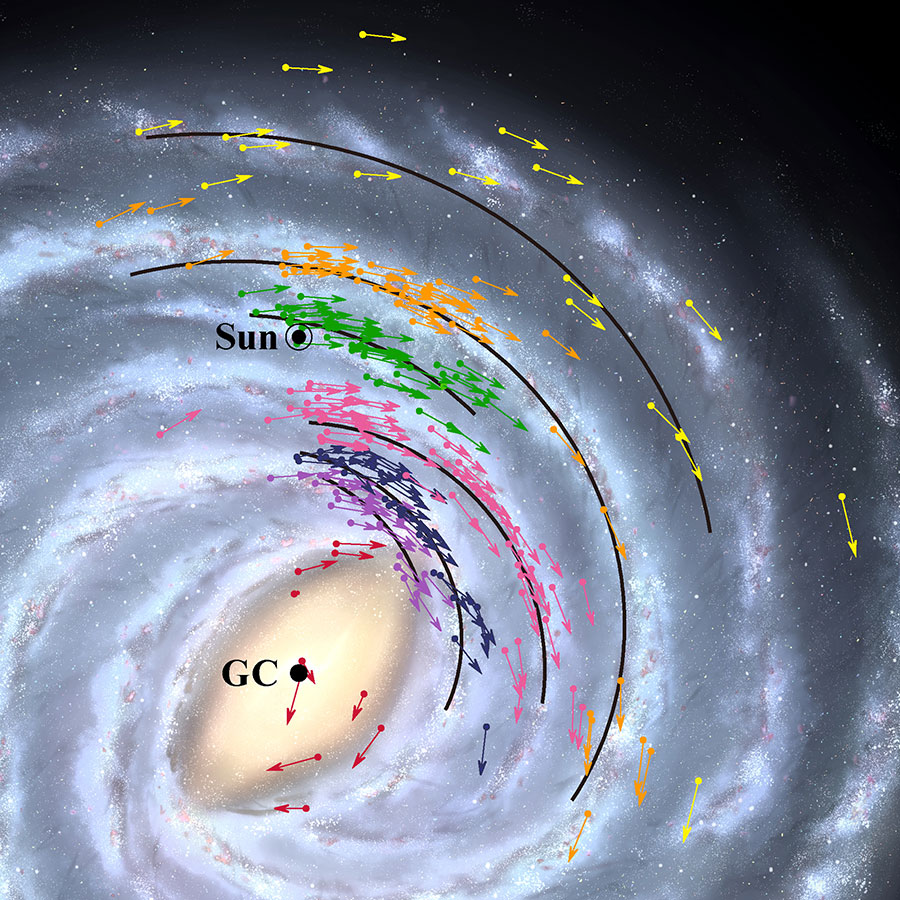Skip to comments.
Earth Is a Whole Lot Closer to Our Galaxy's Supermassive Black Hole Than We Thought
Science Alert ^
| 11/27/2020
| Michelle Starr
Posted on 11/27/2020 10:36:44 PM PST by LibWhacker
Earth Is a Whole Lot Closer to Our Galaxy's Supermassive Black Hole Than We Thought MICHELLE STARR 27 NOVEMBER 2020 It seems that Earth has been misplaced. According to a new map of the Milky Way galaxy, the Solar System's position isn't where we thought it was. Not only is it closer to the galactic centre - and the supermassive hole therein, Sagittarius A* - it's orbiting at a faster clip.
It's nothing to be concerned about; we're not actually moving closer to Sgr A*, and we're in no danger of being slurped up. Rather, our map of the Milky Way has been adjusted, more accurately identifying where we have been all along. And the survey beautifully demonstrates how tricky it is to map a galaxy in three dimensions from inside it. It's a problem that has long devilled our understanding of space phenomena. It's relatively easy to map the two-dimensional coordinates of stars and other cosmic objects, but the distances to those objects is a lot harder to figure out. And distances are important - they help us determine the intrinsic brightness of objects. A good recent example of this is the red giant star Betelgeuse, which turned out to be closer to Earth than previous measurements suggested. This means that it's neither as large nor as bright as we thought. Another is the object CK Vulpeculae, a star that exploded 350 years ago. It's actually much farther away, which means that the explosion was brighter and more energetic, and requires a new explanation, since previous analyses were performed under the assumption it was relatively low energy.
But we're getting better at calculating those distances, with surveys using the best available technology and techniques working hard to refine our three-dimensional maps of the Milky Way, a field known as astrometry. And one of these is the VERA radio astronomy survey, conducted by the Japanese VERA collaboration. VERA stands for VLBI (Very Long Baseline Interferometry) Exploration of Radio Astrometry, and it uses a number of radio telescopes across the Japanese archipelago, combining their data to effectively produce the same resolution as a telescope with a 2,300 kilometre- (1,430 mile-) diameter dish. It's the same principle behind the Event Horizon Telescope that produced our very first direct image of a black hole's shadow. VERA, which started observing in 2000, is designed to help us calculate the distances to radio-emitting stars by calculating their parallax. With its incredible resolution, it observes these stars for over a year, and watches how their position changes relative to stars that are much farther away as Earth orbits the Sun.
This change in position can then be used to calculate how far a star is from Earth, but not all parallax observations are created equal. VLBI can produce much higher resolution images; VERA has a breathtaking angular resolution of 10 millionths of an arcsecond, which is expected to produce extraordinarily high precision astrometry measurements. And this is what astronomers have used to refine our Solar System's position in the Milky Way. Based on the first VERA Astrometry Catalog of 99 objects released earlier this year, as well as other observations, astronomers created a position and velocity map of those objects.
From this map, they calculated the position of the galactic centre. In 1985, the International Astronomical Union defined the distance to the galactic centre as 27,700 light-years. Last year, the GRAVITY collaboration recalculated it and found it closer, just 26,673 light-years away.
The VERA-based measurements bring it closer still, to a distance of just 25,800 light-years. And the Solar System's orbital speed is faster, too - 227 kilometres (141 miles) per second, rather than the official velocity of 220 kilometres (137 miles) per second. That change may not seem like much, but it could have an impact on how we measure and interpret activity in the galactic centre - ultimately, hopefully, leading to a more accurate picture of the complex interactions around Sgr A*. Meanwhile, the VERA collaboration is forging ahead. Not only is it continuing to make observations of objects in the Milky Way, it's joining up with an even larger project, the East Asian VLBI Network. Together, astronomers hope, the telescopes involved in this project could provide measurements of unprecedented accuracy
TOPICS: Astronomy; Science
KEYWORDS: astronomy; center; distance; earth; eventhorizon; galactic; science; stringtheory
Navigation: use the links below to view more comments.
first previous 1-20, 21-40, 41-45 next last
To: LibWhacker
The VERA-based measurements bring it closer still, to a distance of just 25,800 light-years.
...
Light is slow.
Imagine if it took you that long to get to the center of your neighborhood.
21
posted on
11/28/2020 3:48:27 AM PST
by
Moonman62
(http://www.freerepublic.com/~moonman62/)
To: Theophilus
The next time some Mask Karen or Lockdown-loving politician preaches "we must follow the science," remind them that
the red giant star Betelgeuse...turned out to be closer to Earth than previous measurements suggested. This means that it's neither as large nor as bright as we thought.As was said elsewhere, science isn't math.
22
posted on
11/28/2020 4:56:05 AM PST
by
DoodleBob
(Gravity's waiting period is about 9.8 m/s^2)
To: LateBoomer
I watched Greenland last night...a movie about earths extinction by asteroids. When you have asteroids and black holes....it’s gonna’ be painful.
To: dayglored
I'm very glad for the correction, nevertheless, because being off by 1900 light-years is nothing to sneeze at.Yep, it's only 11,400,000,000,000,000 miles, give or take.
24
posted on
11/28/2020 5:46:29 AM PST
by
JPG
(MAGA 2020!)
To: mrsmith
Makes quite a difference when you are running for your life!👾
25
posted on
11/28/2020 5:53:48 AM PST
by
6ppc
(Democrats would have to climb Everest to reach the level of "scum of the earth")
To: LibWhacker
Just keep recounting until the black hole wins and we get swallowed.
To: LibWhacker
It’s been nice knowing ye...
27
posted on
11/28/2020 6:34:22 AM PST
by
moovova
To: Steve Van Doorn
I love it! One son has 4 different degrees, 3 being Physics, Math, Computer Science.....2 other sons are engineers - structural and mechanical. Good friend is physics professor. I’m a former science teacher.
Sending this to all.
28
posted on
11/28/2020 6:45:32 AM PST
by
Arlis
To: LibWhacker

Position and velocity map of the Milky Way Galaxy. Arrows show position and velocity data for the 224 objects used to model the Milky Way Galaxy. The solid black lines show the positions of the Galaxy’s spiral arms. The colors indicate groups of objects belonging the same arm. The background is a simulation image. (Credit: NAOJ)
29
posted on
11/28/2020 6:48:12 AM PST
by
Alas Babylon!
("You, the American people, are my only special interest." --President Donald J. Trump)
To: JPG
>
Yep, it's only 11,400,000,000,000,000 miles, give or take. Saw a great astronomy/SETI themed video years ago that showed the Milky Way spiral and the Solar System's approx. position in it, and then started magnifying and closing in on our position. Eventually a tiny blue bubble became visible. That bubble represented the volume of space that had Earth's radio transmissions in it -- with a radius of about 200 light-years.
Very humbling. It put all the talk of communications to/from extraterrestrials into perspective. It also was funny to think that the stuff at the outer edges of the bubble was largely Morse Code, then some voices, and then I Love Lucy.
30
posted on
11/28/2020 8:16:46 AM PST
by
dayglored
("Listen. Strange women lying in ponds distributing swords is no basis for a system of government."`)
To: dayglored
Earth Is a Whole Lot Closer to Our Galaxy’s Supermassive Black Hole Than We Thought
I don’t know. I always thought it was centered right at the DOJ.
31
posted on
11/28/2020 8:36:08 AM PST
by
JayAr36
(My disgust with government is complete.)
To: LibWhacker
One day (or night), you won’t have to worry about letting the dog out for a wee wee ... sssssWWWOOOOOPPppp!!!
The universe is a cold hard place to survive in, some know that all too well these days.
32
posted on
11/28/2020 9:22:09 AM PST
by
NormsRevenge
(Semper Fi - Monthly Donors Rock!!! Help beat the leftist media at their own game.)
To: LibWhacker
"The VERA-based measurements bring it closer still, to a distance of just 25,800 light-years." Excellent news!
That means our 1985 Ford 500 can make it on 2 x 1019 tank-fills...
My old lady has agreed to make the trip, but only if there are lots of casinos along the way...
33
posted on
11/28/2020 10:07:07 AM PST
by
SuperLuminal
(Where is Sam Adams now that we desperately need him)
To: LibWhacker
The Black Hole the Dems tried to use for Trump’s votes has a giant leak.......
To: Arlis
Notice he points out that the sun must have a lithosphere it would go against every law of thermodynamics if it didn't. Pierre is great.
My simple takes. Chondrite meteorites are known to only come from the sun. How can the sun be a gas yet meteorites are flying off it. Both can't be true. Density of the sun also does not make any sense. They base this on the compression of a liquid?
35
posted on
11/28/2020 10:28:12 AM PST
by
Steve Van Doorn
(*in my best Eric Cartman voice* 'I love you, guys')
To: Alas Babylon!
I always thought we were in one of the outer most arms... this pc shows we are we are mid way in!! I finding this pic hard to believe from what weve seen from earth based optics. Strong milkyway on one side and virtually nothing on the other.
36
posted on
11/28/2020 10:42:28 AM PST
by
sit-rep
( )
To: Larry Lucido
Is it called the kessel run?
37
posted on
11/28/2020 12:06:21 PM PST
by
BiteYourSelf
( Earth first we'll strip mine the other planets later.)
To: sit-rep
Well, it is true.
The reason it is so much brighter on one side is the huge bulge that is the galactic center.
The rest of the galaxy is like a record album, and we’re just sitting in some groove.
38
posted on
11/28/2020 12:16:24 PM PST
by
Alas Babylon!
("You, the American people, are my only special interest." --President Donald J. Trump)
To: 6SJ7; AdmSmith; AFPhys; Arkinsaw; allmost; aristotleman; autumnraine; bajabaja; ...
39
posted on
11/28/2020 12:35:46 PM PST
by
SunkenCiv
(Imagine an imaginary menagerie manager imagining managing an imaginary menagerie.)
To: Alas Babylon!
Even if we were closer in, say halfway again as far on the edge-on view, it would appear much brighter on the side of the GC. I hope this pic isn't too big...

40
posted on
11/28/2020 3:11:10 PM PST
by
Alas Babylon!
("You, the American people, are my only special interest." --President Donald J. Trump)
Navigation: use the links below to view more comments.
first previous 1-20, 21-40, 41-45 next last
Disclaimer:
Opinions posted on Free Republic are those of the individual
posters and do not necessarily represent the opinion of Free Republic or its
management. All materials posted herein are protected by copyright law and the
exemption for fair use of copyrighted works.
FreeRepublic.com is powered by software copyright 2000-2008 John Robinson


